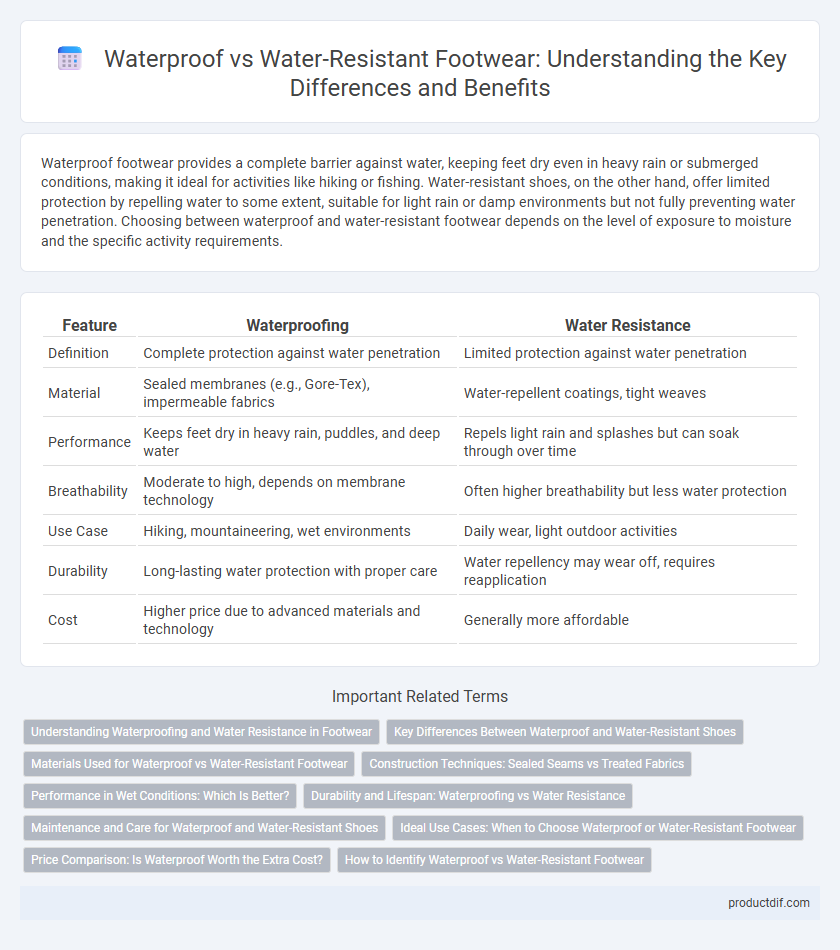Waterproof footwear provides a complete barrier against water, keeping feet dry even in heavy rain or submerged conditions, making it ideal for activities like hiking or fishing. Water-resistant shoes, on the other hand, offer limited protection by repelling water to some extent, suitable for light rain or damp environments but not fully preventing water penetration. Choosing between waterproof and water-resistant footwear depends on the level of exposure to moisture and the specific activity requirements.
Table of Comparison
| Feature | Waterproofing | Water Resistance |
|---|---|---|
| Definition | Complete protection against water penetration | Limited protection against water penetration |
| Material | Sealed membranes (e.g., Gore-Tex), impermeable fabrics | Water-repellent coatings, tight weaves |
| Performance | Keeps feet dry in heavy rain, puddles, and deep water | Repels light rain and splashes but can soak through over time |
| Breathability | Moderate to high, depends on membrane technology | Often higher breathability but less water protection |
| Use Case | Hiking, mountaineering, wet environments | Daily wear, light outdoor activities |
| Durability | Long-lasting water protection with proper care | Water repellency may wear off, requires reapplication |
| Cost | Higher price due to advanced materials and technology | Generally more affordable |
Understanding Waterproofing and Water Resistance in Footwear
Waterproof footwear uses sealed seams and specialized membranes like Gore-Tex to completely block water from entering, making it ideal for wet conditions and heavy rain. Water-resistant shoes employ coated fabrics or treatments such as DWR (Durable Water Repellent) to repel light moisture but may allow water penetration during prolonged exposure. Understanding the distinction between waterproof and water-resistant materials helps consumers select the right footwear for varying weather conditions and activities.
Key Differences Between Waterproof and Water-Resistant Shoes
Waterproof shoes feature fully sealed seams and materials designed to prevent any water penetration, making them ideal for heavy rain and wet conditions. Water-resistant shoes repel water to a certain degree through treated fabrics or coatings but may allow moisture to seep in during prolonged exposure. The key difference lies in the level of protection: waterproof shoes offer complete barrier against water, while water-resistant shoes provide limited defense suitable for light rain or splashes.
Materials Used for Waterproof vs Water-Resistant Footwear
Waterproof footwear typically utilizes materials such as Gore-Tex, rubber, and polyurethane coatings to create a fully sealed barrier against water penetration. Water-resistant footwear often incorporates tightly woven fabrics, treated leather, and durable water repellent (DWR) finishes that repel light moisture but do not prevent water from entering after prolonged exposure. The choice of materials directly impacts the level of protection and breathability, with waterproof options offering superior defense through specialized membranes and sealed seams.
Construction Techniques: Sealed Seams vs Treated Fabrics
Waterproof footwear uses sealed seams that prevent water from penetrating through stitch holes, ensuring complete barrier protection. Water-resistant shoes rely on treated fabrics coated with hydrophobic materials like DWR (Durable Water Repellent) to repel light moisture but can allow water ingress under prolonged exposure. Sealed seam construction offers superior moisture protection in harsh conditions, while treated fabrics provide breathability and moderate water defense for everyday use.
Performance in Wet Conditions: Which Is Better?
Waterproof footwear offers complete protection by preventing any water penetration, making it ideal for prolonged exposure to wet conditions such as heavy rain or snow. Water-resistant shoes provide limited defense that repels light moisture and splashes but can eventually allow water to seep through during extended use. For superior performance in consistently wet environments, waterproof shoes outperform water-resistant models by maintaining dryness and comfort throughout the day.
Durability and Lifespan: Waterproofing vs Water Resistance
Waterproof footwear offers superior durability and a longer lifespan due to its fully sealed construction that prevents water infiltration, protecting the materials from damage and deterioration. Water-resistant shoes, while effective against light moisture, use coatings that can wear off over time, reducing their protective capability and durability. Investing in waterproof footwear ensures sustained performance and longevity, especially in consistently wet or harsh environments.
Maintenance and Care for Waterproof and Water-Resistant Shoes
Maintaining waterproof shoes requires regular cleaning and reapplying specialized waterproofing sprays or treatments to preserve the integrity of sealed membranes like Gore-Tex. Water-resistant shoes benefit from routine surface cleaning and occasional application of water-repellent coatings to sustain their protective layer against moisture penetration. Proper drying methods, such as air drying away from direct heat sources, are essential for both types to prevent material degradation and extend footwear lifespan.
Ideal Use Cases: When to Choose Waterproof or Water-Resistant Footwear
Waterproof footwear is ideal for activities involving prolonged exposure to wet conditions such as hiking in rainy weather or crossing streams, ensuring complete protection from moisture. Water-resistant shoes suit everyday use where occasional splashes or light rain occur, offering breathability and comfort without the bulk of waterproof materials. Choosing between the two depends on the intensity and duration of water exposure as well as the required level of breathability for the activity.
Price Comparison: Is Waterproof Worth the Extra Cost?
Waterproof footwear typically commands a higher price due to advanced materials like Gore-Tex and sealed seams, offering complete protection against water infiltration ideal for heavy-duty use. Water-resistant shoes use less expensive coatings or treatments that repel water but may fail in prolonged exposure, making them a budget-friendly option for light moisture conditions. Investing in waterproof footwear is worth the extra cost for activities requiring extended water exposure or harsh weather, while water-resistant shoes suffice for everyday wear and mild dampness.
How to Identify Waterproof vs Water-Resistant Footwear
Waterproof footwear is identified by sealed seams, waterproof membranes like Gore-Tex, and materials that block water entry completely, ensuring feet stay dry in heavy rain or submersion. Water-resistant shoes use tightly woven fabrics or coatings such as DWR (Durable Water Repellent) that repel light moisture but may allow water penetration under prolonged exposure. Labels, product descriptions, and testing standards like ISO 20344 help consumers distinguish between waterproof and water-resistant footwear effectively.
Waterproofing vs Water Resistance Infographic

 productdif.com
productdif.com